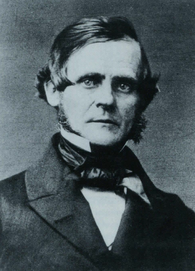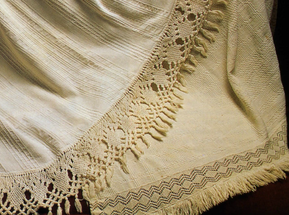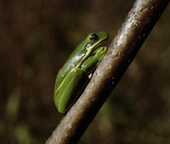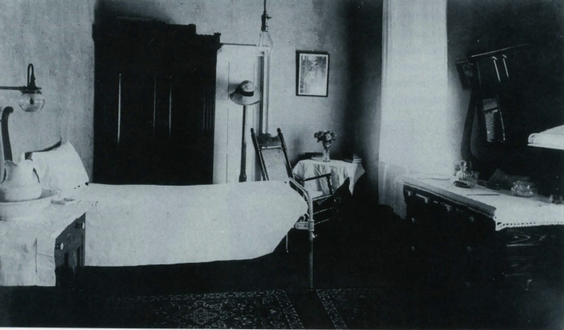|
On the cover: William Frye, one of nineteenth-century Alabama's most prolific artists, completed this portrait of Mrs. Hugh Watson Rutland (Sarah Louise Goodloe) in the 1860s. (Courtesy Mrs. R. E. Hereford)
|
FEATURE ABSTRACTS
 Thomas Story Kirkbride (1809-1883), a leading proponent of moral treatment for the insane, influenced the architectural plans for the Alabama Insane Hospital. (Courtesy Historic Archives, Institute of the Pennsylvania Hospital)
Thomas Story Kirkbride (1809-1883), a leading proponent of moral treatment for the insane, influenced the architectural plans for the Alabama Insane Hospital. (Courtesy Historic Archives, Institute of the Pennsylvania Hospital)
Mental Health and Moral Architecture
By Robert O. Mellown
In the 1790s, mental health patients were often confined to hospital basements or chained by the waist or ankles to the walls of ten-foot square cells. But in the 1930s, activists Thomas Kirkbride and Dorothea Dix fought for moral medical treatment of the mentally ill, including an architectural environment more conducive to recovery. And author Robert O. Mellown tells the story of how, in 1852, Alabama became the first state to appropriate sufficient funds for the construction of a mental hospital designed in the new moral architecture, detailing the Alabama Insane Hospital (now Bryce Hospital). Mellown outlines the workings of the hospital, along with changes in the treatment of mental illness both in medical concepts and philosophy of architectural design since the hospital's construction, and how Bryce Hospital has dealt with these changes.
Additional Information
Kirkbride, Thomas S. On the Construction, Organization and General Arrangements of Hospitals for the Insane (Philadelphia, 1880).
About the Author
A frequent contributor to Alabama Heritage, Robert Mellown is an associate professor of art history at the University of Alabama. In 1987 he received a grant from the Alabama Historical Commission to write an historic structures report on the hospital. During the three years Mellown worked on the project, he conducted an architectural investigation of the main hospital and support buildings and studied hospital records and relevant materials in the University of Alabama's special collections library. Betsy Hayslip, Executive Director of the Heritage Commission of Tuscaloosa County, and Kathy Fetters, Staff Librarian, Bryce Hospital, assisted Mellown in his research for both the histOric structures report and this article.
By Robert O. Mellown
In the 1790s, mental health patients were often confined to hospital basements or chained by the waist or ankles to the walls of ten-foot square cells. But in the 1930s, activists Thomas Kirkbride and Dorothea Dix fought for moral medical treatment of the mentally ill, including an architectural environment more conducive to recovery. And author Robert O. Mellown tells the story of how, in 1852, Alabama became the first state to appropriate sufficient funds for the construction of a mental hospital designed in the new moral architecture, detailing the Alabama Insane Hospital (now Bryce Hospital). Mellown outlines the workings of the hospital, along with changes in the treatment of mental illness both in medical concepts and philosophy of architectural design since the hospital's construction, and how Bryce Hospital has dealt with these changes.
Additional Information
Kirkbride, Thomas S. On the Construction, Organization and General Arrangements of Hospitals for the Insane (Philadelphia, 1880).
- Mellown, Robert O. Bryce Hospital Historic Structures Report (Heritage Commission of Tuscaloosa County, 1990).
- _______. "The Construction of the Alabama Insane Hospital, 1852-1861," Alabama Review XXXVIII (April 1985): 83-104.
- Tomes, Nancy. A Generous Confidence: Thomas Story Kirkbride and the Art of Asylum-Keeping, 1840-1883 (Cambridge University Press, 1984).
About the Author
A frequent contributor to Alabama Heritage, Robert Mellown is an associate professor of art history at the University of Alabama. In 1987 he received a grant from the Alabama Historical Commission to write an historic structures report on the hospital. During the three years Mellown worked on the project, he conducted an architectural investigation of the main hospital and support buildings and studied hospital records and relevant materials in the University of Alabama's special collections library. Betsy Hayslip, Executive Director of the Heritage Commission of Tuscaloosa County, and Kathy Fetters, Staff Librarian, Bryce Hospital, assisted Mellown in his research for both the histOric structures report and this article.
Insights into an Insane Asylum
By John S. Hughes
In May 1881, thinking he was on a pleasant trip to Tuscaloosa with his family, seventy-year-old Reverend Joseph Camp was admitted to the Alabama Insane Hospital by his wife and son-in-law. The shock of being admitted to the hospital only grew during Camp's next five months and twenty days as a patient there. Upon returning to his family in November, Camp published his book, entitled An Insight into an Insane Asylum, at his own expense. Camp's book notes the treatment he received as a mental patient of the Alabama Insane Hospital, including practices of nurses and physicians that often border on cruelty. To this day, Camp's book remains the only significant exposé of the Alabama Insane Hospital ever written.
Additional Information
About the Author
John Hughes holds a Ph.D. in history from Rice University, where he specialized in the study of American legal and medical history. A former Bankhead Fellow in American History at the University of Alabama and a former Research Fellow in legal history at New York University School of Law, Hughes has taught history at the University of Alabama and the University of Texas and is the author of The Letters of a Victorian Madwoman (University of South Carolina Press, 1992) and In the Law's Darkness: Isaac Ray and the Medical Jurisprudence of Insanity in Nineteenth-Century America (New York University School of Law, 1986). He is currently working on a manuscript entitled "The Kindness of Strangers: Insanity, Commitment and Care in the Victorian South."
By John S. Hughes
In May 1881, thinking he was on a pleasant trip to Tuscaloosa with his family, seventy-year-old Reverend Joseph Camp was admitted to the Alabama Insane Hospital by his wife and son-in-law. The shock of being admitted to the hospital only grew during Camp's next five months and twenty days as a patient there. Upon returning to his family in November, Camp published his book, entitled An Insight into an Insane Asylum, at his own expense. Camp's book notes the treatment he received as a mental patient of the Alabama Insane Hospital, including practices of nurses and physicians that often border on cruelty. To this day, Camp's book remains the only significant exposé of the Alabama Insane Hospital ever written.
Additional Information
- Grob, Gerald N. Mental Illness and American Society, 1875-1940 ( Princeton University Press, 1983).
- Hughes, John. "Commitment, Family Stress, and Legal Culture: The Case of Victorian Alabama," in The Constitution, Law and American Society: Critical Aspects of the Nineteenth-Century Experience, Donald Nieman, ed. (University of Georgia Press, 1992): 133-161.
- _______ . "Country Boys Make the Best Nurses: Nursing the Insane in Alabama, 1861-1910," Journal of the History of Medicine and Allied Sciences (January 1994).
- _______ . "Labelling and Treating Black Mental Illness in Alabama, 1861-1910," Journal of Southern History 58 (August 1992): 435-59.
- _______ . "The Madness of Separate Spheres: Masculinity and Insanity in Victorian Alabama," in Meanings for Manhood: Constructions of Masculinity in Victorian America, Mark C. Carnes and Claude Griffen, eds. (University of Chicago Press, 1990): 53-66.
- _______ . "New Solutions to Old Problems: Commitment Law and Family Distress in Alabama, 1861-1900," Workshop on the Legal History of the American Family, University of Wisconsin School of Law, Working Papers Series 2 (May 1987).
- Bryce Hospital (Alabama Insane Hospital)
- Medical Association of the State of Alabama (MASA)
- Peter Bryce
- Autoclave at Bryce Hospital
- Bryce Hospital Bedroom
- Bryce Hospital Laundry
- Bryce Hospital Patient Ward
- Bryce Hospital Staff Meeting
- Bryce Hospital
- Peter Bryce
About the Author
John Hughes holds a Ph.D. in history from Rice University, where he specialized in the study of American legal and medical history. A former Bankhead Fellow in American History at the University of Alabama and a former Research Fellow in legal history at New York University School of Law, Hughes has taught history at the University of Alabama and the University of Texas and is the author of The Letters of a Victorian Madwoman (University of South Carolina Press, 1992) and In the Law's Darkness: Isaac Ray and the Medical Jurisprudence of Insanity in Nineteenth-Century America (New York University School of Law, 1986). He is currently working on a manuscript entitled "The Kindness of Strangers: Insanity, Commitment and Care in the Victorian South."
 Of Frye's portrait (c. 1856) of her daughters Sarah Louise and Mary, Mrs. Goodloe declared, "I would not take a million for the picture." (Courtesy Mrs. Waler E. Morris)
Of Frye's portrait (c. 1856) of her daughters Sarah Louise and Mary, Mrs. Goodloe declared, "I would not take a million for the picture." (Courtesy Mrs. Waler E. Morris)
William Frye, Artist
By E. Bryding Adams
In nineteenth-century Alabama, few portrait painters were more successful or more prolific than William Frye. Although his paintings captured a record of the state's well-to-do families, Frye himself has remained largely unrecognized during the past one hundred years. But with the publication in the 1960s of new studies on portrait books from Southern states, Frye and other artists have begun to receive attention from art dealers, museums, and collectors. While pointing out Frye's signature painting styles and techniques, author E. Bryding Adams follows the life and artistic career of William Frye, from his beginnings in Alabama to the prosperous 1850s and the hard times of the Civil War. The article is accompanied by striking images of Frye's work, including both landscapes and portraits for which he is best remembered.
Additional Information
About the Author
A native Alabamian, E. Bryding Adams is Curator of Decorative Arts at the Birmingham Museum of Art. In 1985 she initiated the Alabama Decorative Arts Survey to examine private and public collections throughout the state for ceramics, furniture, metals, paintings, photography, and textiles made in Alabama prior to 1930. While conducting the survey, which included searches in nineteenth- and early twentieth-century newspapers, Adams and her associates uncovered information on hundreds of heretofore little-known artisans like William Frye. She welcomes additional information about Frye, his sitters, as well as information about other Alabama artisans for a forthcoming exhibition and catalog entitled "Made in Alabama: A State Legacy" opening at the Birmingham Museum of Art in October 1994.
Bryding Adams maintains a checklist of all the paintings by William Frye identified to date. A copy of that list may be obtained by writing her at the Birmingham Museum of Art, 2000 Eighth Avenue North, Birmingham, Alabama 35203-2278.
The author wishes to dedicate this article to Dr. Winston Smith and for research assistance to thank Dr. S. Richardson Hill, Sara Elizabeth Mason, Mrs. Herbert Nation, Leon T. Hinds, Mrs. W. T. Goodloe Rutland, and Dr. Marion G. McGuinn.
By E. Bryding Adams
In nineteenth-century Alabama, few portrait painters were more successful or more prolific than William Frye. Although his paintings captured a record of the state's well-to-do families, Frye himself has remained largely unrecognized during the past one hundred years. But with the publication in the 1960s of new studies on portrait books from Southern states, Frye and other artists have begun to receive attention from art dealers, museums, and collectors. While pointing out Frye's signature painting styles and techniques, author E. Bryding Adams follows the life and artistic career of William Frye, from his beginnings in Alabama to the prosperous 1850s and the hard times of the Civil War. The article is accompanied by striking images of Frye's work, including both landscapes and portraits for which he is best remembered.
Additional Information
- Bennett, Suwannee, and William B. Worthen. Arkansas Made, Vol.II (University of Arkansas Press, 1990).
- Fisk, Sarah Huff. "Howard Weeden, Artist and Poet," Alabama Review XIV (April 1 961): 124-37.
- Hill Ferguson Papers, Hale/Frye Family, Birmingham Public Library Archives.
- National Society of the Colonial Dames of America in the State of Alabama. Alabama Portraits Prior to 1870 (Gill Printing and Stationary Co., 1969).
- Register of the Kentucky State Historical Society. "History of G. Wm. Frye- Artist," Letter from Minnie Frye Coleman, Vol. 13, No. 39, September 1915.
- Stanley, C. M. "William Frye and Early Alabama Portraits," Alabama Joumal, Ocrober 27, 1957.
About the Author
A native Alabamian, E. Bryding Adams is Curator of Decorative Arts at the Birmingham Museum of Art. In 1985 she initiated the Alabama Decorative Arts Survey to examine private and public collections throughout the state for ceramics, furniture, metals, paintings, photography, and textiles made in Alabama prior to 1930. While conducting the survey, which included searches in nineteenth- and early twentieth-century newspapers, Adams and her associates uncovered information on hundreds of heretofore little-known artisans like William Frye. She welcomes additional information about Frye, his sitters, as well as information about other Alabama artisans for a forthcoming exhibition and catalog entitled "Made in Alabama: A State Legacy" opening at the Birmingham Museum of Art in October 1994.
Bryding Adams maintains a checklist of all the paintings by William Frye identified to date. A copy of that list may be obtained by writing her at the Birmingham Museum of Art, 2000 Eighth Avenue North, Birmingham, Alabama 35203-2278.
The author wishes to dedicate this article to Dr. Winston Smith and for research assistance to thank Dr. S. Richardson Hill, Sara Elizabeth Mason, Mrs. Herbert Nation, Leon T. Hinds, Mrs. W. T. Goodloe Rutland, and Dr. Marion G. McGuinn.
 Special knotting and weaving techniques were used to create decorative boarders for bed covers, as the intricate Leno-weave edging, delicately knotted fringe, and uncommon knitted-lace edging on these mid-nineteenth century Alabama-made counterpanes demonstrate. (From the collections of Lee W. Rahe and Cat. Henry J. Skipper, USN retired)
Special knotting and weaving techniques were used to create decorative boarders for bed covers, as the intricate Leno-weave edging, delicately knotted fringe, and uncommon knitted-lace edging on these mid-nineteenth century Alabama-made counterpanes demonstrate. (From the collections of Lee W. Rahe and Cat. Henry J. Skipper, USN retired)
- Alabama's Handwoven Counterpanes
By Lee W. Rahe and Charlotte Jirousek
During the Nineteenth-century, counterpanes were a familiar type of bed covering in the South, a product of the cotton-producing economy of the period. This article presents the different weaves and finishes traditionally associated with handwoven counterpanes, and traces the evolution of their development as handmade objects in the midst of advancing technology to become treasured heirlooms in many Southern families.
Additional Information
Atwater, Mary Meigs. The Shuttlecraft Book of American Handweaving (Macmillan, 1940).
Eaton, Allen H. Handicrafts of the Southern Highlands(Russell Sage Foundation, 1937).
- Jemian, Pat Jackson. Chattahoochee Coverlets (Arts and Humanities Center, Auburn University, 1987).
- Jirousek, Charlotte A., and Lee W. Rahe, "Alabama's Handwoven Counterpanes: The Other Coverlet," Ars Textrina, 17 (June 1992): 167-1 92.
- Lohrenz, Mary Edna, and Anita Miller Stamper. Mississippi Homespun: Nineteenth-Century Textiles and the Women Who Made Them (Mississippi Dept. of Archives and History, 1989).
- Coat of Many Colors
- Crazy Quilt
- Freedom Quilting Bee 1 of 4 (video)
- Freedom Quilting Bee 2 of 4 (video)
- Freedom Quilting Bee 3 of 4 (video)
- Freedom Quilting Bee 4 of 4 (video)
- Gee’s Bend Quilters
- Star Design Quilt
- Star Pattern Quilt
About the Author
Lee Rahe, a member of the interior design faculty at the University of Alabama, holds a Ph.D. in Human Ecology from the University of Tennessee at Knoxville and an M.A. in Housing and Interior Design from the University of Missouri at Columbia. Rahe is currently engaged in research on the residential furnishings and furnishing practices of antebellum Southerners.
After receiving a Ph.D. in applied design from the University of Minnesota, Charlotte Jirousek taught the history of costume and textiles at the University of Alabama for four years. Jirousek is now on the faculty of Cornell University.
The editors wish to thank Mr. Marvin Harper of Northport, Alabama, for providing several of his heirloom counterpanes and coverlet for this article and for allowing Alabama Heritage to photograph them in his home.
DEPARTMENT ABSTRACTS
Southern Architecture and Preservation
The Hopkins Pratt House at River Bend
By Jeff Mansell
The Hopkins Pratt house, now in perilous condition, is one of the few examples of a hall-and-parlor-plan I-house remaining in Alabama. Tragically, as this issue was going to press, the Hopkins Pratt house was torn down. With its destruction, we have lost a significant part of our heritage and gained yet another sad illustration of the need for both documentation of our historic structures and public education regarding our architectural legacy.
Additional Information
The following article in the Encyclopedia of Alabama will also be of interest:
About the Author
Jeff Mansell is assistant director, Cahaba Trace Commission.
The Hopkins Pratt House at River Bend
By Jeff Mansell
The Hopkins Pratt house, now in perilous condition, is one of the few examples of a hall-and-parlor-plan I-house remaining in Alabama. Tragically, as this issue was going to press, the Hopkins Pratt house was torn down. With its destruction, we have lost a significant part of our heritage and gained yet another sad illustration of the need for both documentation of our historic structures and public education regarding our architectural legacy.
Additional Information
The following article in the Encyclopedia of Alabama will also be of interest:
About the Author
Jeff Mansell is assistant director, Cahaba Trace Commission.
 A green treefrog sleeps peacefully on a sumac branch. (Photograph by Larry Davenport)
A green treefrog sleeps peacefully on a sumac branch. (Photograph by Larry Davenport)
The Nature Journal
Green Treefrogs
By L. J. Davenport
L.J. Davenport examines the life- and mating-habits of the green treefrog.
Additional Information
The following article in the Encyclopedia of Alabama will also be of interest: Multimedia:
About the Author
Larry Davenport is a professor of biology at Samford University, Birmingham.
Green Treefrogs
By L. J. Davenport
L.J. Davenport examines the life- and mating-habits of the green treefrog.
Additional Information
The following article in the Encyclopedia of Alabama will also be of interest: Multimedia:
About the Author
Larry Davenport is a professor of biology at Samford University, Birmingham.

